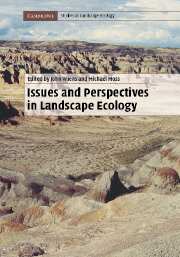Book contents
- Frontmatter
- Contents
- List of contributors
- Preface
- PART I Introductory perspectives
- PART II Theory, experiments, and models in landscape ecology
- PART III Landscape patterns
- PART IV Landscape dynamics on multiple scales
- PART V Applications of landscape ecology
- PART VI Cultural perspectives and landscape planning
- 26 The nature of lowland rivers: a search for river identity
- 27 Using cultural knowledge to make new landscape patterns
- 28 The critical divide: landscape policy and its implementation
- 29 Landscape ecology: principles of cognition and the political–economic dimension
- 30 Integration of landscape ecology and landscape architecture: an evolutionary and reciprocal process
- 31 Landscape ecology in land-use planning
- PART VII Retrospect and prospect
- Index
- Plate section
- References
31 - Landscape ecology in land-use planning
from PART VI - Cultural perspectives and landscape planning
Published online by Cambridge University Press: 20 November 2009
- Frontmatter
- Contents
- List of contributors
- Preface
- PART I Introductory perspectives
- PART II Theory, experiments, and models in landscape ecology
- PART III Landscape patterns
- PART IV Landscape dynamics on multiple scales
- PART V Applications of landscape ecology
- PART VI Cultural perspectives and landscape planning
- 26 The nature of lowland rivers: a search for river identity
- 27 Using cultural knowledge to make new landscape patterns
- 28 The critical divide: landscape policy and its implementation
- 29 Landscape ecology: principles of cognition and the political–economic dimension
- 30 Integration of landscape ecology and landscape architecture: an evolutionary and reciprocal process
- 31 Landscape ecology in land-use planning
- PART VII Retrospect and prospect
- Index
- Plate section
- References
Summary
When you see the geese fly south or you suddenly get a glimpse of a badger, you do not easily realize that they have a target to go for. The geese fly south to migrate from their breeding grounds in the north of Europe, Asia, or America to their winter biotope. The badger goes along his usual route for foraging. Common toads migrate in large groups from their hibernation shelter to the water, where they have been born, to deposit their eggs. Salmon try to find their way up the streams to their spawning grounds. Storks return to their nests from Africa just like people return home from their holidays. It sounds very human, for in this behavior there is not much difference between wild species and mankind. As long as the migration routes are available and without too much danger for the species, we do not notice it, because they come and go. The birds fly over, the badger passes in the night just like the toads, and the only thing most people notice are the toad eggs in the water and the stork when it has returned to its nest.
Under the influence of changes in human food demands, caused by demographic trends, the cultivated area of North America and Europe has shown considerable fluctuations. Agricultural areas move from one region to another, forests are removed in one part of the world and forests of exotic species are planted elsewhere.
- Type
- Chapter
- Information
- Issues and Perspectives in Landscape Ecology , pp. 316 - 328Publisher: Cambridge University PressPrint publication year: 2005
References
- 7
- Cited by

